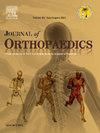Motion mapping and positioning of lumbrical muscles in the carpal tunnel-a cadaveric study
IF 1.5
Q3 ORTHOPEDICS
引用次数: 0
Abstract
Aims and objectives
Dynamic incursion of lumbrical muscle proximal to the distal edge of transverse carpal ligament (TCL) has been long debated for its role in causing median nerve compression in the carpal tunnel. This study aims to evaluate the pattern of lumbrical incursion into the carpal tunnel in various finger positions and determine their extent of presence and relationship with respect to the TCL and to each other in the carpal tunnel.
Materials & methods
Dissection of 30 fresh frozen cadaveric hands was done to map the lumbrical muscles. The distance from each lumbrical muscle's proximal origin to the TCL's distal edge was measured using a Vernier caliper in three finger positions namely full extension, lumbrical, and full flexion position. Statistical tests like paired t-test, ANOVA and Chi-Square test were used to evaluate the mean changes in lumbrical incursion, percentage of incursion, relative positions and the proportion of hands showing lumbrical origins proximal to the TCL.
Results
The second lumbrical exhibited the highest mean incursion in all finger positions, followed by the third. Significant increases in incursion were observed from full extension to lumbrical position and from lumbrical position to full flexion in all lumbricals. The number of hands with lumbrical origins proximal to the TCL increased significantly from complete extension to complete flexion.
Conclusions
Lumbrical incursion significantly increases the content within the carpal tunnel with various finger positions. In full flexion, there is significant pressure of lumbricals within the tunnel. Hence, along with the tendons and median nerve, the lumbricals should be considered a dynamic content of the carpal tunnel. These muscles could 1significantly contribute to idiopathic Carpal tunnel syndrome in the backdrop of alteration in tunnel size or content. The second lumbrical, due to its proximal-most origin, is pivotal in this process.
Level of evidence
Level V.
腕管蚓状肌的运动测绘和定位-尸体研究。
目的和目的:蚓状肌近端到远端腕横韧带(TCL)的动态侵入在腕管中引起正中神经压迫的作用一直存在争议。本研究旨在评估不同手指位置下蚓状侵入腕管的模式,并确定它们在腕管中与TCL和彼此之间的存在程度和关系。材料与方法:对30例新鲜冰冻尸体进行解剖,绘制蚓状肌肉分布图。使用游标卡尺在三个手指位置(即完全伸展、蚓状和完全屈曲位置)测量从每块蚓状肌的近端起点到TCL远端边缘的距离。采用配对t检验、方差分析和卡方检验等统计检验评价蚓状侵入、蚓状侵入百分比、相对位置和在TCL近端显示蚓状起源的手的比例的平均变化。结果:第2指位平均侵入量最大,第3指位次之。从完全伸展到蚓状位以及从蚓状位到完全屈曲,所有蚓状位都观察到明显的侵犯增加。在TCL近端有蚓状起源的手的数量从完全伸展到完全屈曲显著增加。结论:蚓状侵及不同指位均可显著增加腕管内的内容物。在完全屈曲时,隧道内的腰椎有明显的压力。因此,与肌腱和正中神经一样,蚓状肌应该被认为是腕管的一个动态内容。在腕管大小或内容改变的背景下,这些肌肉可能对特发性腕管综合征有重要影响。第二个蚓状体,由于其最近的起源,在这个过程中是关键的。证据等级:V级。
本文章由计算机程序翻译,如有差异,请以英文原文为准。
求助全文
约1分钟内获得全文
求助全文
来源期刊

Journal of orthopaedics
ORTHOPEDICS-
CiteScore
3.50
自引率
6.70%
发文量
202
审稿时长
56 days
期刊介绍:
Journal of Orthopaedics aims to be a leading journal in orthopaedics and contribute towards the improvement of quality of orthopedic health care. The journal publishes original research work and review articles related to different aspects of orthopaedics including Arthroplasty, Arthroscopy, Sports Medicine, Trauma, Spine and Spinal deformities, Pediatric orthopaedics, limb reconstruction procedures, hand surgery, and orthopaedic oncology. It also publishes articles on continuing education, health-related information, case reports and letters to the editor. It is requested to note that the journal has an international readership and all submissions should be aimed at specifying something about the setting in which the work was conducted. Authors must also provide any specific reasons for the research and also provide an elaborate description of the results.
 求助内容:
求助内容: 应助结果提醒方式:
应助结果提醒方式:


